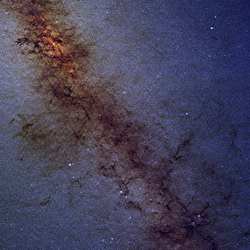
The center of our Milky Way galaxy. Image credit: NASA. Click to enlarge
Astronomers are studying nearby “luminous infrared galaxies” to get a better idea of what extremely distant galaxies might look like. Some of these galaxies are 1/50th the size of the Milky Way (2000 light-years across), but they have the same amount of gas. This tightly packed gas causes nearly constant star formation, and feeds supermassive black holes. This is probably what the early Universe looked like.
If you can’t travel to the picturesque sands of Waikiki Beach, you can always do the next-best thing and visit a local shore. Both “hot spots” will get plenty of sun.
Astronomers are using a similar sightseeing tactic, studying nearby extreme galaxies known as “luminous infrared galaxies” to learn about their distant counterparts in the early universe. Astronomer Christine Wilson (Smithsonian Astrophysical Observatory/McMaster University) and her colleagues have found some surprising commonalities between these extreme galaxies and their mundane cousins like the Milky Way.
“These galaxies are unusual in some ways, but surprisingly normal in others,” said Wilson. “They’re like giant sequoias – they look spectacular, but they grow from the same dirt as your basic shrub.”
Wilson presented her team’s findings today in a press conference at the 208th meeting of the American Astronomical Society.
Luminous and ultraluminous infrared galaxies are islands of stars and dust that emit the great majority (90-99 percent) of their light at long infrared wavelengths. All known examples show evidence for galaxy interactions and mergers that are stirring them up. Gas and dust crash together at the centers of these galaxies, fueling tremendous bursts of star formation or feeding giant central black holes.
“All the action in these galaxies is happening at their centers,” said Wilson.
Similar interactions were much more common in the early universe when galaxies were closer together. Observations have detected many examples of extreme galaxies at distances of 8 to 10 billion light-years. At those great distances, detailed study is difficult with current instruments, hence astronomers’ interest in their nearby counterparts.
To investigate these galactic “hot spots,” Wilson and her colleagues employed the Smithsonian’s Submillimeter Array. The high spatial resolution of the Array was crucial for this study, allowing the team to probe galactic centers where most of the star formation is taking place.
“Some of these galaxies have as much gas as the Milky Way crammed into a region only 2,000 light-years across – one-fiftieth (1/50) the size of our Galaxy,” explained Wilson.
About three-fourths of the time, that gas powers bursts of star formation. In other cases, the gas feeds a giant black hole. Either way, a lot of energy gets pumped out in the infrared.
Wilson and her colleagues determined the total amounts of gas and dust within each of the five most luminous galaxies they studied. They divided the two numbers to calculate the gas-to-dust ratio.
Galaxies like the Milky Way typically contain about 100 times more gas than dust. Surprisingly, the extreme infrared galaxies showed similar values.
“Given their unusual environment, I’m not sure I would have expected to see a normal gas to dust ratio,” said Wilson. “The fact that we DO see a normal value suggests not only that our mass calculations are correct, but also that these galaxies are more like our own than we might have guessed.”
Luminous infrared galaxies also show some interesting differences from their cousins in the early universe. For example, distant galaxies typically are 10 times brighter in molecular emissions, which indicates that they contain more gas. That gas also tends to move faster, providing evidence that the galaxies are more massive. Most interestingly, distant extreme galaxies appear to be larger in size, which suggests that the gas density may actually be lower in these distant galaxies despite their larger total amount of gas.
Future work by Wilson and her team will focus on determining how galaxy properties change as interactions and mergers progress over time.
Headquartered in Cambridge, Mass., the Harvard-Smithsonian Center for Astrophysics (CfA) is a joint collaboration between the Smithsonian Astrophysical Observatory and the Harvard College Observatory. CfA scientists, organized into six research divisions, study the origin, evolution and ultimate fate of the universe.
Original Source: CfA News Release
